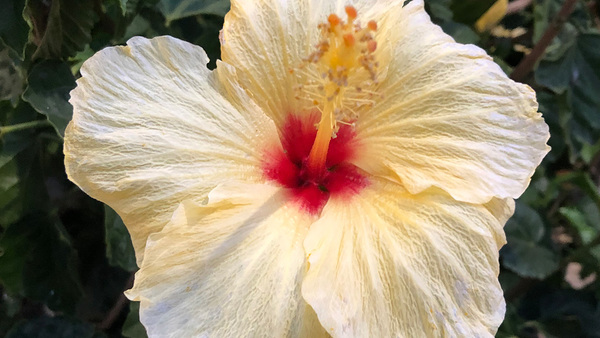
Just when the heat and dryness of a Southwestern summer are starting to get to you, fall brings some respite. The plus side of living in such a warm region is that we have a multitude of plants that look good at every time of the year. The following are some of my favorite shrubs with fall interest for our region; these plants offer beautiful flowers, interesting seed heads, or fiery fall foliage. Best of all, these three shrubs are native and perfectly adapted to our climate.

Rubber rabbitbrush
Ericameria nauseosa subsp. nauseosa var. glabrata, Zones 4–9
Rubber rabbitbrush, also called chamisa, is an excellent fall-blooming plant. This shrub is extremely drought tolerant, with very low water requirements. It’s also hardy up to 8,500 feet above sea level. The blooms are bright yellow and feathery, appearing on the very end of the woody branches starting in late summer. The turquoise to green branches create beautiful contrast with the flowers. Rubber rabbitbrush will reach 2 to 6 feet tall and wide, depending on conditions, although there are even smaller varieties available.
This shrub prefers full sun and heat. It would appreciate being situated near a heat island, such as a wall, a building, or a driveway. Don’t plant it near a walkway, though, as it will spread and become cumbersome. You will need to prune it back too far, which will make the plant unattractive. The leaves have a pungent aroma that keeps deer and rabbits from browsing. However, birds and other critters use the dense branches to seek shelter from predators. Consider planting rubber rabbitbrush in groups of three or five, which will maximize the fall display. Trim them back in January or February after most snowfall has finished for the season. Avoid trimming the seed heads back until late winter; the snow will blanket them and look magical, and wildlife will eat them. If you have a woody, overgrown rabbitbrush, select deadwood to prune out and open it up a bit; this will also encourage new growth.

Apache plume
Fallugia paradoxa, Zones 4–9
Apache plume is an awesome shrub in many ways. First, it blooms consistently from spring through fall with single roselike flowers. These flowers then turn into feathery seed heads. The white of the flowers and pink of the seed heads create a constant color display. Second, this shrub looks great year-round with its shaggy, whiteish stems that are sparsely covered in small, finely dissected light green leaves. These branches have an airy habit. And third, this is an easy-care, low-maintenance shrub. It also has some of the lowest water requirements you’ll find. At 8,500 feet above sea level, its elevation hardiness is similar to that of rubber rabbitbrush, which makes these two shrubs perfect to pair together if you live at a high elevation.
This shrub normally grows 3 to 6 feet tall and wide, but I’ve seen the rare Apache plume reach 10 feet in diameter, so make sure you provide adequate room for it to spread its wings. Many people plant this shrub in constrictive spaces or trim it into hot-air-balloon shapes. There is no need for this if it is planted in appropriate locations with enough room. This plant can withstand the hottest, most arid environments. I’ve seen Apache plumes growing in rock walls, arroyos, and freeways, where they get the most punishing exposure. This shrub is a trooper, for sure. The only thing that will make it truly suffer is shade, so be sure to provide a minimum of six hours of full sun. I don’t recommend any annual pruning for this shrub; it looks best as is.

Three-leaf sumac
Rhus trilobata, Zones 4–8
This last shrub is one of my go-to plants because of its amazing adaptability and hardiness. I don’t know about you, but I need plants that will not struggle or be finicky after planting. Three-leaf sumac always starts thriving immediately after I plant it. During the growing season, it has glossy, dark green leaves that are separated into three leaflets, and small clusters of yellow flowers. But during autumn, the foliage transitions from green to yellow to orange and then to a gorgeous fiery red. This drought-tolerant shrub has very low water requirements. It will thrive not only in blazing sun but also in partial shade. Deer and rabbits avoid this plant, but birds and other wildlife love it. Three-leaf sumac will survive up to 9,000 feet of elevation.
This shrub will look fine with shaping or pruning, which makes people want to plant it in oasis zones or highly visible areas of their property. The size of this shrub can vary a lot; it typically grows 3 to 8 feet tall and 3 to 6 feet wide, but mature specimens may reach up to 12 feet tall and wide. You can prune it or leave it alone. If you’re looking for a shrub to work where others haven’t, this is the shrub for you.
These shrubs need a regular watering schedule until establishment, but then they can become completely nondependent on additional watering. In light of continuing drought, planting shrubs that can survive on their own after establishment is important. Southwestern gardeners all want plants that thrive no matter what is thrown at them. These tough, native shrubs are just what we need.
For more plants that look great during fall in the Southwest, check out:
- Unusual Fall Perennials for the Southwest
- Plants With Fantastic Fall Interest for the Southwest
- Shrubs That Bloom All Year Long in the Southwest
And for more Southwest regional reports, click here.
—Mark Brotton, APLD, owns and operates Living Water, Irrigation, and Landscape based in Santa Fe, New Mexico.


















Comments
Log in or create an account to post a comment.
Sign up Log in